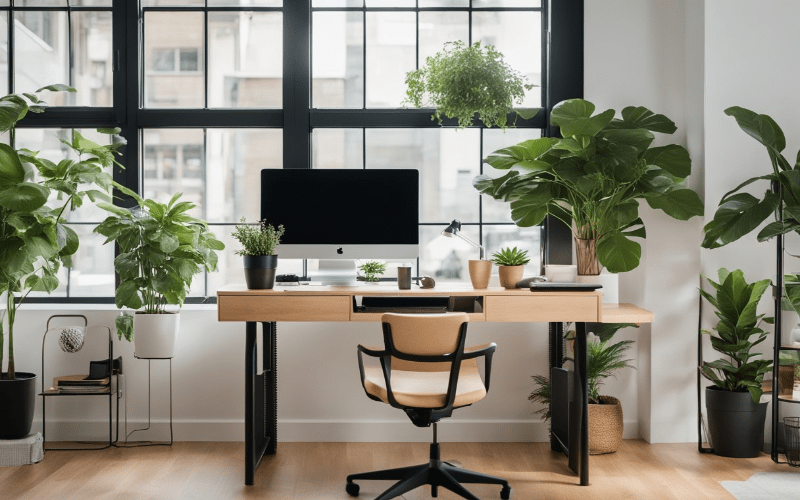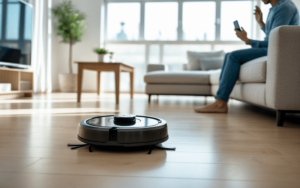Creating a home office that supports both wellness and productivity is essential in today’s work-from-home culture.
Comfort and efficiency can be dramatically improved by incorporating ergonomic products into your workspace.
Choosing the right ergonomic office equipment can significantly reduce strain and enhance efficiency.

From adjustable desks to supportive chairs, ergonomic furniture plays a crucial role in maintaining good posture and reducing fatigue.
Innovative tools and technology, like laptop stands and ergonomic keyboards, further support a healthier work environment.
Integrating these elements not only boosts comfort but also fosters a more productive work atmosphere.
Key Takeaways
- Ergonomic products improve comfort and efficiency.
- Proper furniture and tools reduce strain.
- Healthy work habits enhance productivity.
Understanding Ergonomics in the Home Office

Creating a proper ergonomic setup at home can greatly impact health and productivity.
By minimizing strain and promoting natural posture, individuals can work more comfortably and efficiently.
The Importance of Ergonomics
Ergonomics plays a critical role in designing a home office that enhances comfort and productivity.
A well-structured workspace reduces the risk of physical strain and discomfort.
Ensuring that the chair, desk, and computer are set at optimal heights encourages healthy posture.
Proper ergonomics also improve focus and efficiency. When individuals are comfortable, they can work longer without pain or distraction.
Investing in ergonomic furniture, like chairs with lumbar support or adjustable desks, can greatly enhance the overall work environment.
Common Ergonomic Issues and Risks
Many common issues arise from poor ergonomic setups at home.
One prevalent problem is the wrong chair height, leading to bent wrists and strained shoulders.
Sitting incorrectly can cause back and neck pain.
Another risk involves improper monitor placement, which can result in eye strain and headaches.
Screens should ideally be at eye level to maintain natural head and neck alignment.
Additionally, extended periods of keyboard use without adequate wrist support can lead to carpal tunnel syndrome.
Addressing these issues is vital for maintaining physical well-being and optimizing work performance.
Taking regular breaks and doing stretches can also help reduce the risks associated with long hours at a desk.
Ergonomic Furniture Essentials
Crafting a comfortable and healthy workspace is essential for maintaining productivity and well-being.
Ergonomic furniture plays a crucial role in preventing discomfort and reducing the risk of strain injuries.
This section focuses on adjustable chairs, versatile desks, and strategic desk arrangement to create an optimal work environment.
We may earn a small commission if you purchase through this link. Thank you for supporting our content!
Adjustable Chairs for Posture Support
An ergonomic chair is vital for maintaining good posture.
Features such as lumbar support, adjustable height, and tilt functions help align the spine properly.
Lumbar support reduces strain on the lower back by supporting the natural curve of the spine.
Chairs with adjustable armrests can help keep shoulders relaxed and prevent wrist fatigue.
Materials and cushion variety also play a role in comfort.
High-density foam and breathable fabrics like mesh increase comfort for extended periods.
For more information about key features, consider exploring options like ergonomic office chairs recommended by experts.
Sit-Stand Desks and Converters
Sit-stand desks offer flexibility to switch between sitting and standing throughout the day.
Regularly changing position can help reduce the risk of posture-related issues.
Height-adjustable desks can be manual or electric, allowing for effortless transitions.
While standing, using an anti-fatigue mat can help reduce discomfort in the legs and feet.
Converters are also a valuable alternative. They sit atop existing desks and transform them into a standing desk.
There are different types available, such as those with a gas spring lift system that makes height adjustment easy.
Learn more about standing desks and their benefits for your workspace setup.
Ergonomic Desk Layout and Accessories
Arranging your desk ergonomically can make a significant difference in comfort.
Monitor stands keep screens at eye level, preventing neck strain by avoiding looking down or up.
Keyboard trays help maintain neutral wrist positioning, reducing the risk of carpal tunnel syndrome.
Accessories like footrests can improve circulation and relieve back stress by allowing feet to rest flat.
Cable management systems keep wires organized, reducing clutter and creating a tidy appearance.
For a selection of useful ergonomic accessories, consider products designed to enhance your home office functionality.
Ergonomic Tools and Technology
Ergonomic tools play a crucial role in enhancing comfort and productivity in a home office.
By focusing on user-centric design, these tools reduce strain and fatigue, allowing for a more efficient workspace.
The following sections explore various solutions that address these common office challenges.
Keyboards and Mice Designed for Comfort
Ergonomic keyboards and mice are essential for reducing hand and wrist strain.
They are designed to promote a more natural hand position and often feature split-key layouts or curved surfaces to align the hands properly.
For instance, some keyboards come with adjustable typing angles and padded wrist rests, offering additional support.
Ergonomic mice, on the other hand, are shaped to fit the contours of the user’s hand. They reduce the need to twist the wrist unnaturally.
Options such as trackball mice or vertical mice can considerably lower the risk of repetitive strain injuries.
When selecting these devices, it’s important to consider size, grip style, and ease of use to ensure maximum comfort.
Monitor Stands and Document Holders
Proper screen height is critical to avoiding neck and shoulder pain.
Monitor stands and document holders adjust your screen to eye level, minimizing the need to tilt your head.
This ensures that the monitor is an appropriate distance from the eyes, usually about an arm’s length with the top of the screen at or slightly below eye level.
Using a monitor stand allows for easy adjustment and can accommodate multiple monitors, creating a seamless work environment.
Document holders, placed between the keyboard and monitor, make it easier to reference paperwork without awkward neck movements.
Adjustable stands usually cater to various work habits, allowing for both sitting and standing positions, promoting better posture overall.
Creating a Wellness-Focused Environment
Designing a home office with wellness in mind involves considering both lighting and air quality.
Proper lighting reduces eye strain, while optimal air quality boosts comfort and productivity.
Lighting and Glare Reduction
Good lighting in a workspace reduces eye strain and enhances focus.
Natural light is the best, so positioning a desk near windows is ideal. When natural light is limited, consider using LED desk lamps that mimic daylight.
Avoid placing screens directly in front of windows to prevent glare.
Using monitor stands can help set screens at a comfortable viewing angle, reducing glare.
Adjustable blinds or curtains allow for control over the amount and direction of incoming light. Anti-glare screen protectors can also be beneficial.
In addition, task lighting, like a desk lamp, provides focused light on work areas, reducing reliance on overhead lighting.
Indoor Air Quality and Temperature Control
Maintaining good indoor air quality is crucial for health and productivity.
Plants such as spider plants and peace lilies naturally purify air.
Investing in air purifiers can remove allergens and pollutants, keeping the air fresh and breathable.
Consistent temperature control is also important.
A comfortable temperature range prevents distractions caused by being too hot or cold.
Consider using fans or portable heaters to adjust the temperature as needed.
Humidity levels matter too.
Using humidifiers can help maintain comfortable air moisture levels, reducing dryness that might irritate the skin and eyes.
Regular cleaning and proper ventilation also contribute to a healthier workspace.
Incorporating Movement and Breaks

Incorporating movement into a workday can greatly improve wellness and productivity. Short breaks, or microbreaks, are useful for keeping energy levels high. These breaks can be as simple as a quick walk or a few minutes of stretching. This practice can reduce fatigue and enhance focus.
Ideas for Quick Movement Breaks:
- Stretching: Gentle stretches can relieve muscle tension.
- Walking: A brief walk around the home or office helps clear the mind.
- Office Exercises: Try standing leg lifts or desk push-ups.
Benefits of Movement and Breaks:
- Increased productivity
- Better concentration
- Reduced risk of injury
Using products like standing desks can encourage more movement. For those working from home, consider a treadmill or bike that pairs with a desk.
Regular movement is crucial for managing work-related musculoskeletal disorders. Encouraging a routine of movement and breaks creates a healthier work environment, which can boost morale and efficiency.
Frequently Asked Questions
Selecting the right ergonomic products and practices can greatly improve comfort and efficiency in a home office. Understanding the role of ergonomic accessories, desks, chairs, and office arrangement is essential for creating a space that supports health and productivity.
What are the essential ergonomic accessories for a productive home office setup?
To enhance productivity, ergonomic accessories like adjustable chairs, keyboard trays, and monitor stands are critical. These items help maintain proper posture and reduce strain during long work hours. For more details, check here.
How does an ergonomic desk enhance workplace wellness and productivity?
An ergonomic desk provides space for organizing equipment at the correct height, allowing for a more comfortable posture. Adjustable desks can even encourage alternating between sitting and standing, which reduces fatigue and boosts focus.
What are the top ergonomic practices to follow for a home office environment?
Key practices include setting up the monitor at eye level, using support for wrists, and ensuring feet rest flat on the floor. These adjustments reduce the risk of injury and help maintain concentration.
Which ergonomic chair features contribute to a healthy home office workspace?
A good ergonomic chair offers lumbar support, adjustable height, and a recline feature. These attributes support the spine’s natural curve and distribute body weight evenly, preventing back pain.
How should one arrange a home office to maximize ergonomics and comfort?
Arranging a home office involves placing the computer monitor at eye level, positioning the keyboard for neutral wrist posture, and keeping essential tools within arm’s reach to avoid strain.
What key factors should be considered when choosing ergonomic laptop accessories?
Laptop accessories like external keyboards and stands play a vital role. They prevent forward head posture by raising the laptop screen to eye level, reducing neck and shoulder tension.
For more insights, visit Logitech Ergo Lab.
This article contains affiliate links, which means we may earn a commission if you purchase through our links, at no extra cost to you. Thank you for supporting our content!




